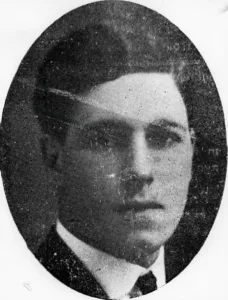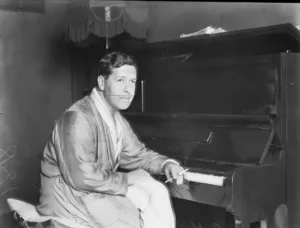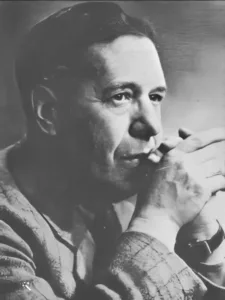From Australia’s Jewish Past:
Arthur Leslie Benjamin
COMPOSER & CONDUCTOR: music was his life
First published in J-Wire March 15, 2022

Arthur Leslie Benjamin was born on September 18, 1893, in Sydney. At the age of three, his family moved to Brisbane.
Benjamin made his first public appearance as a pianist at the age of six, but only commenced formal musical training at the age of nine, with the Brisbane City organist as his teacher. He won a scholarship from Brisbane Grammar School to attend the Royal College of Music (RCM) in London, where he studied composition, harmony, and piano.
In 1914 he joined the Officer Training Corps and served initially in the infantry with the 32nd Battalion of the Royal Fusiliers, and in November 1917, he joined the Royal Flying Corps. In July 1918, his aircraft was shot down over Germany, and he spent the remainder of the war as a German prisoner at Ruhleben Internment Camp near Berlin.
Whilst in camp, he met the composer Edgar Bainton, who had been interned since 1914 and later became Director of the NSW Conservatorium of Music.
Arthur’s internment did not stop his composing, and the manuscript of the unpublished Violin Sonata in E minor bears the date 1918, which appears to be his only composition during this time.
In 1919 Arthur returned to Australia and became a professor of piano at the NSW Conservatorium of Music. Two years later, he returned to England to become a professor of law at the Royal College of Music, and in 1926, he was appointed to a full professorship, a position he held for the next thirteen years.
He had a distinguished career as a piano teacher, and many of his students went on to be well-known pianists and composers. Two to be mentioned are Natasha Litvin, who became the second wife of Sir Stephen Spender – renowned English poet, novelist, and essayist as well as a prominent concert pianist – and Benjamin Britten, whose Holiday Diary suite for solo piano is dedicated to Arthur and mimics many of his teacher’s mannerisms. He concentrated on writing chamber works for violin, piano, voice, string, and cello for the next few years.
1924 was a particular year as he wrote a unique chamber piece – Pastoral Fantasy – which won him a Carnegie Award, together with an invitation to perform George Gershwin’s masterpiece – Rhapsody in Blue – at its premiere in London.
By 1927, Arthur was composing orchestral and crafted songs for choral settings, and, this he continued to do for the next eleven years. He joined the Associated Board of the Royal Schools of Music in 1929 as an adjudicator and examiner and this led him back to Australia and Canada and the West Indies. It was in the West Indies that he discovered the native tune – Mango Walk – on which he based his best-known piece, Jamaican Rumba, one of two Jamaican pieces composed in 1938, for which the Jamaican government gave him a free barrel of rum a year as thanks for making their country known. In 1945, a shortened piano solo arrangement of the Jamaican Rumba was published.

For the next few years, Arthur had the opportunity to conduct the BBC Symphony Orchestra, as well as to manage a concert tour of Europe with a ten-year-old Canadian cellist – Lorne Munroe. Arthur was so taken by her amazing talent, that he wrote a sonatina for her and Lorne went on to become the principal cellist with the Philadelphia Orchestra and the New York Philharmonic. She also recorded the piece.
In 1941, Arthur retired from the RCM, settled in Vancouver, and remained there until after the Second World War. He was appointed conductor of the newly-formed Canadian Broadcasting Corporation Symphony Orchestra, a post he held until 1946. During this time he became a major figure in Canadian musical life, giving “literally hundreds” of first performances, radio talks, concerts, teaching, conducting, and composing.
He frequently visited the United States, broadcasting and arranging many performances of contemporary British music. It was in the US that Arthur became associated with Larry Adler, the well-known American harmonica player, and wrote a harmonica concerto for him, which was performed many times and recorded at least twice.
Arthur also wrote music for opera and one opera in particular – Mañana – a full-length opera, which was first produced during the Festival of Britain in 1951, and won him a gold medal. In 1953, it was broadcast in a live performance by BBC Radio and then produced by BBC Television in early 1956. Unfortunately, it was judged a flop at the time and was not heard again. Arthur did revise this opera into its final version which was successfully produced in San Francisco in April 1960 – only days before Arthur’s death.
Arthur’s love of composing extended to the world of film and in 1934 he wrote the music for The Scarlet Pimpernel; Alfred Hitchcock’s The Man Who Knew Too Much (and for the remake in 1956); An Ideal Husband in 1947, Storm Clouds Cantata and Fire Down Below in 1957, as well as several others.
 It is sad to know that, whilst the musical scores are archived in the British Library, the film scores were completely lost, other than that for An Ideal Husband and Storm Clouds Cantata.
It is sad to know that, whilst the musical scores are archived in the British Library, the film scores were completely lost, other than that for An Ideal Husband and Storm Clouds Cantata.
In 1957 Arthur was honoured with the Cobett Medal for Chamber Music by the Worshipful Company of Musicians – an extremely prestigious award.
Arthur died on 10 April 1960 at the age of 66 and is buried in London. His estate was left to his devoted partner, Jack Henderson, a Canadian who worked in the music publishing business. Jack died in 1995.
It has been reported that Arthur’s music was neglected for many years and, it is pleasing to know that in more recent times, Ian Munro, a well-known composer and musician and great admirer of Arthur’s works, has brought Arthur’s music to light, and has recorded a number of these compositions.
